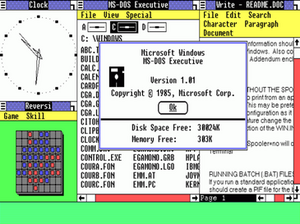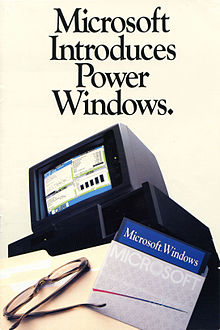 |
| Screenshot of Microsoft Windows 1.01 |
Today's Highlight in History:
1985 – Microsoft Windows 1.0 is released.
Windows 1.0 is a graphical personal computer operating environment developed by Microsoft. Its development was spearheaded by the company founder, The development of Windows was spearheaded by the Microsoft founder, Bill Gates, after seeing a demonstration at COMDEX 1982 of Visi On, a graphical user interface software suite for IBM PC compatibles.
First released on 20 November 1985 as the first version of the Microsoft Windows line, Windows 1.0 runs as a graphical, 16-bit multi-tasking shell on top of an existing MS-DOS installation, providing an environment which can run graphical programs designed for Windows, as well as existing MS-DOS software.
Version 1.02, released in May 1986, was an international release. Version 1.03, released in August 1986 included enhancements that made it consistent with the international release. It included drivers for European keyboards and additional screen and printer drivers. Version 1.04, released in April 1987, added support for the new IBM PS/2 computers, although no support for PS/2 mice or new VGA graphics modes was provided. At the same time, Microsoft and IBM announced the introduction of OS/2 and its graphical OS/2 Presentation Manager, which were supposed to ultimately replace both MS-DOS and Windows.
Despite positive responses to its early presentations and support from a number of hardware and software makers, Windows 1.0 was received poorly by critics, who felt it did not meet their expectations. In particular, they felt that Windows 1.0 put too much emphasis on mouse input at a time when mouse use was not yet widespread; not providing enough resources for new users; and for suffering from performance issues, especially on systems with lower hardware specifications. Despite this criticism, Windows 1.0 proved to be an important milestone for Microsoft, and in computer history in general. Windows 1.0 was officially declared obsolete and unsupported by Microsoft on 31 December 2001.
In November 1987, Windows 1.0 was succeeded by Windows 2.0. Microsoft supported Windows 1.0 for 16 years, until 31 December 2001 – the longest out of all versions of Windows.
Windows 1.0 offers limited multitasking of existing MS-DOS programs and concentrates on creating an interaction paradigm (cf. message loop), an execution model and a stable API for native programs for the future. Due to Microsoft's extensive support for backward compatibility, it is not only possible to execute Windows 1.0 binary programs on current versions of Windows to a large extent, but also to recompile their source code into an equally functional "modern" application with just limited modifications.
 |
| Microsoft Windows 1.0 brochure, printed in January 198 |
Because graphics support in MS-DOS is extremely limited, MS-DOS applications have to go to the bare hardware (or sometimes just to the BIOS) to get work done. Therefore, Windows 1.0 included original device drivers for video cards, a mouse, keyboards, printers and serial communications, and applications were supposed to only invoke APIs built upon these drivers. However, this extended to other APIs such as file system management functions. In this sense, Windows 1.0 was designed to be extended into a full-fledged operating system, rather than being just a graphics environment used by applications. Indeed, Windows 1.0 is a "DOS front-end" and cannot operate without a DOS environment (it uses, for example, the file-handling functions provided by DOS.) The level of replacement increases in subsequent versions.
Windows 1.0 was regarded as a flop by contemporary technology publications, who, however, still acknowledged its overall importance to the history of the Windows line.
Wikipedia
1789 – New Jersey becomes the first U.S. state to ratify the Bill of Rights.
1805 – Ludwig van Beethoven's only opera, Fidelio premieres in Vienna.
1917 – Ukraine is declared a republic.
1936 – José Antonio Primo de Rivera, founder of the Falange, is killed by a republican execution squad.
1940 – World War II: Hungary becomes a signatory of the Tripartite Pact, officially joining the Axis powers.
1947 – The Princess Elizabeth marries Lieutenant Philip Mountbatten, who becomes the Duke of Edinburgh, at Westminster Abbey in London.
1962 – Cuban missile crisis ends: In response to the Soviet Union agreeing to remove its missiles from Cuba, U.S. President John F. Kennedy ends the quarantine of the Caribbean nation.
1968 - A total of 78 miners are killed in an explosion at the Consolidated Coal Company’s No. 9 mine in Farmington, West Virginia in the Farmington Mine disaster
1969 – Vietnam War: The Plain Dealer publishes explicit photographs of dead villagers from the My Lai Massacre in Vietnam.
1974 – The United States Department of Justice files its final anti-trust suit against AT&T Corporation. This suit later leads to the breakup of AT&T and its Bell System.
1977 – Egyptian President Anwar Sadat becomes the first Arab leader to officially visit Israel, when he meets Israeli prime minister Menachem Begin and speaks before the Knesset in Jerusalem, seeking a permanent peace settlement.
1979 – Grand Mosque Seizure: About 200 Sunni Muslims revolt in Saudi Arabia at the site of the Kaaba in Mecca during the pilgrimage and take about 6000 hostages. The Saudi government receives help from Pakistani special forces to put down the uprising.
1980 – Lake Peigneur drains into an underlying salt deposit. A misplaced Texaco oil probe had been drilled into the Diamond Crystal Salt Mine, causing water to flow down into the mine, eroding the edges of the hole.
1982 – The General Union of Ecuadorian Workers (UGTE) is founded.
1985 – Microsoft Windows 1.0 is released.
1992 – In England, a fire breaks out in Windsor Castle, badly damaging the castle and causing over £50 million worth of damage.
1993 – Savings and loan crisis: The United States Senate Ethics Committee issues a stern censure of California senator Alan Cranston for his "dealings" with savings-and-loan executive Charles Keating.
1994 – The Angolan government and UNITA rebels sign the Lusaka Protocol in Zambia, ending 19 years of civil war. (Localized fighting resumes the next year.)
1998 – A court in Taliban-controlled Afghanistan declares accused terrorist Osama bin Laden "a man without a sin" in regard to the 1998 U.S. embassy bombings in Kenya and Tanzania.
1998 – The first module of the International Space Station, Zarya, is launched.
2001 – In Washington, D.C., U.S. President George W. Bush dedicates the United States Department of Justice headquarters building as the Robert F. Kennedy Justice Building, honoring the late Robert F. Kennedy on what would have been his 76th birthday.
2003 – After the November 15 bombings, a second day of the 2003 Istanbul bombings occurs in Istanbul, Turkey, destroying the Turkish head office of HSBC Bank AS and the British consulate.
2008 – After critical failures in the US financial system began to build up after mid-September, the Dow Jones Industrial Average reaches its lowest level since 1997.
World Events
1789 – New Jersey becomes the first U.S. state to ratify the Bill of Rights.
1805 – Ludwig van Beethoven's only opera, Fidelio premieres in Vienna.
1917 – Ukraine is declared a republic.
1936 – José Antonio Primo de Rivera, founder of the Falange, is killed by a republican execution squad.
1940 – World War II: Hungary becomes a signatory of the Tripartite Pact, officially joining the Axis powers.
1947 – The Princess Elizabeth marries Lieutenant Philip Mountbatten, who becomes the Duke of Edinburgh, at Westminster Abbey in London.
1962 – Cuban missile crisis ends: In response to the Soviet Union agreeing to remove its missiles from Cuba, U.S. President John F. Kennedy ends the quarantine of the Caribbean nation.
1968 - A total of 78 miners are killed in an explosion at the Consolidated Coal Company’s No. 9 mine in Farmington, West Virginia in the Farmington Mine disaster
1969 – Vietnam War: The Plain Dealer publishes explicit photographs of dead villagers from the My Lai Massacre in Vietnam.
1974 – The United States Department of Justice files its final anti-trust suit against AT&T Corporation. This suit later leads to the breakup of AT&T and its Bell System.
1977 – Egyptian President Anwar Sadat becomes the first Arab leader to officially visit Israel, when he meets Israeli prime minister Menachem Begin and speaks before the Knesset in Jerusalem, seeking a permanent peace settlement.
1979 – Grand Mosque Seizure: About 200 Sunni Muslims revolt in Saudi Arabia at the site of the Kaaba in Mecca during the pilgrimage and take about 6000 hostages. The Saudi government receives help from Pakistani special forces to put down the uprising.
1980 – Lake Peigneur drains into an underlying salt deposit. A misplaced Texaco oil probe had been drilled into the Diamond Crystal Salt Mine, causing water to flow down into the mine, eroding the edges of the hole.
1982 – The General Union of Ecuadorian Workers (UGTE) is founded.
1985 – Microsoft Windows 1.0 is released.
1992 – In England, a fire breaks out in Windsor Castle, badly damaging the castle and causing over £50 million worth of damage.
1993 – Savings and loan crisis: The United States Senate Ethics Committee issues a stern censure of California senator Alan Cranston for his "dealings" with savings-and-loan executive Charles Keating.
1994 – The Angolan government and UNITA rebels sign the Lusaka Protocol in Zambia, ending 19 years of civil war. (Localized fighting resumes the next year.)
1998 – A court in Taliban-controlled Afghanistan declares accused terrorist Osama bin Laden "a man without a sin" in regard to the 1998 U.S. embassy bombings in Kenya and Tanzania.
1998 – The first module of the International Space Station, Zarya, is launched.
2001 – In Washington, D.C., U.S. President George W. Bush dedicates the United States Department of Justice headquarters building as the Robert F. Kennedy Justice Building, honoring the late Robert F. Kennedy on what would have been his 76th birthday.
2003 – After the November 15 bombings, a second day of the 2003 Istanbul bombings occurs in Istanbul, Turkey, destroying the Turkish head office of HSBC Bank AS and the British consulate.
2008 – After critical failures in the US financial system began to build up after mid-September, the Dow Jones Industrial Average reaches its lowest level since 1997.


No comments:
Post a Comment